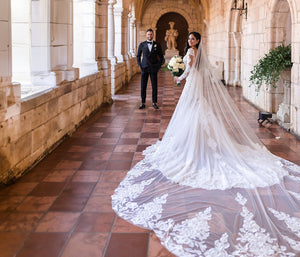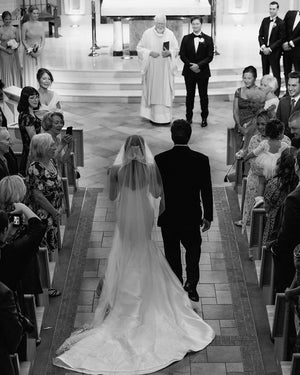You may also like
The wedding veil is a piece of bridal attire that’s been respected, questioned, and transformed throughout centuries of weddings around the world. Its presence often evokes a feeling of mystery and grace, but its significance extends far beyond its beauty.
So, what does the veil mean spiritually?
The answer reaches back through centuries of tradition, spirituality, and cultural evolution. In this blog, we’ll explore the deeper symbolism of the wedding veil, unraveling its hidden meanings and why it still resonates with brides today.
The Ancient Origins of the Wedding Veil
The history of the veil goes back thousands of years. In ancient cultures such as Rome and Greece, the veil was believed to protect the bride from evil spirits. Weddings were seen as special moments where a bride could be vulnerable to bad luck or harmful forces. The veil acted as a protective shield, guarding her from these threats as she entered into her new life as a wife.

An ancient Rome wedding. source: SPQR | Ancient Rome and the Ancient World
So, what does veil mean spiritually from this ancient perspective? It was a symbol of protection, a way to keep the bride safe and pure as she took a significant step into a new, transformative chapter of her life.
A Symbol of Purity and Humility
In many cultures and religious traditions, the wedding veil has long been seen as a symbol of purity. The act of wearing a veil, particularly in Christian weddings, reflects modesty and innocence. It is often linked to the Virgin Mary, who is a symbol of spiritual purity and grace.
But the veil also represents something deeper—humility. The veil as a symbol speaks to centuries of cultural meaning and tradition. To cover oneself with a veil in many cultural traditions is to show modesty and respect for the sacredness of marriage and the important commitment she is embarking on. In this way, the wedding veil is for the bride to honor the sacredness of marriage, showing her willingness to step into this new role with grace, respect, and love.
The Veil as a Sign of Transformation
Weddings are not just celebrations—they are also moments of transformation. When a bride lifts her veil, she is symbolically crossing over from one phase of her life to another. In spiritual terms, the veil represents this transition, marking the change from single life to married life.
Just as a butterfly emerges from a cocoon, the bride, when her veil is lifted, steps into her new role as a wife. The veil is a sign of the unseen changes happening beneath the surface, as the bride moves from one stage of life to another, ready to embrace her new identity.

Bride: Paulina Leal - Zapopan, Mexico. Photo: danielagtzh.com. Veil: Lilly
What does veil mean spiritually in this sense? It’s a powerful symbol of change and transformation, reflecting the personal growth that comes with marriage.
The Hidden and the Revealed
A veil covers the bride’s face, adding a layer of mystery. But spiritually, what does this act of covering symbolize? The veil can be seen as a representation of the barrier which hides aspects of the bride’s soul, the parts of herself that are not immediately visible to the world, which will soon be lifted for her most trusted companion.
The moment when the veil is lifted is significant. It’s not just about revealing the bride’s face—it’s about revealing her true self. In a spiritual sense, this moment represents openness, honesty, and the willingness to share one’s inner self with another person. The bride, who has been hidden, is now fully revealed in the presence of her partner. This act represents her readiness to be fully seen and known, both physically and spiritually, as she embraces the sacred commitment of marriage.
The Veil as Protection from Negative Energies
In many cultures, the wedding veil has been used as a form of spiritual protection. As mentioned earlier, it was believed that evil spirits or negative energies might try to interfere with a wedding ceremony. The veil acted as a barrier, keeping these harmful influences at bay.
But the veil’s protective qualities can also be seen in a more personal, emotional sense. The veil shields the bride from not only external harm but also from internal fears and doubts. When the bride puts on her veil, she is symbolically surrounding herself with love, trust, and positive energy, ready to take the next step forward without fear.It offers a sense of emotional and spiritual security, allowing the bride to step into her new chapter with peace and assurance, knowing she is safeguarded on her special day.
Connection to the Divine Feminine
The soft, flowing nature of the veil has often been linked to the divine feminine, representing the nurturing and intuitive qualities of womanhood. The veil, in this sense, reminds her of the feminine energy that she brings to the marriage.
When a bride wears a veil, she is not just stepping into the role of wife—she is embracing her connection to the feminine spirit that is both gentle and powerful. Through this connection, the bride taps into the deep, sacred feminine energy that has been honored across cultures and generations. The veil symbolizes the bride's deep connection to her inner strength, wisdom, and intuition, qualities that will guide and support her on the journey of marriage. It represents the powerful blend of grace and resilience that her divine feminine brings to this new chapter of life.
The Spiritual Meaning of the Color of the Veil
The color of the veil also holds spiritual meaning. Traditionally, veils are white, symbolizing purity and innocence. But in some cultures, brides choose different veil colors to represent other qualities. For example, a bride may wear a blue veil to symbolize loyalty and calm, or an ivory veil to represent wisdom and maturity.
In ancient China, brides wore red veils, a color associated with good fortune and happiness. The choice of veil color can reflect the bride’s personal intentions and hopes for her marriage, allowing her to align with the spiritual energy she wishes to bring into her new life.
The wedding veil can be a way for the bride to choose what qualities she wishes to embody and invite into her marriage, using the color of her veil as a spiritual tool.
The Veil as a Journey of Love and Faith
Marriage is not just a legal or social contract—it is a spiritual journey. When a bride wears a veil, she is symbolically stepping into this journey, full of love, trust, and faith. The veil represents the bride’s belief in the strength of her partnership and her faith in the future she and her spouse will build together.

Bride: Haley Bethel - Georgia, USA. Photo: signaphotocollective.com. Veil: Jesi.
The act of walking down the aisle, with the veil softly draping over her face, is a physical expression of this faith. It’s a reminder that love often requires us to trust in the unknown, to take steps forward even when the path isn’t entirely clear. The veil invites both bride and groom to trust in the love that will guide her through the ups and downs of married life.
Thus, the wedding veil becomes a profound emblem of trust, love, and faith—the essential foundations that support a strong and enduring marriage.
Conclusion: The Veil as a Sacred Symbol
At the heart of it, the wedding veil is more than an accessory—it's a sacred symbol that reflects the spiritual nature of marriage. It's seen as a protector from negative energies, a marker of humility, a representation of the divine feminine, and a showcase of the trust and love present in a new marriage. Across cultures, the wedding veil holds deep spiritual significance.
So, next time you ask, what does veil mean spiritually, remember that its meaning is as layered and complex as the act of marriage itself, a beautiful symbol of love, faith, and transformation.
Ready to find your perfect spiritual veil? Visit https://tarabridal.com/ today to explore our handcrafted collection.








